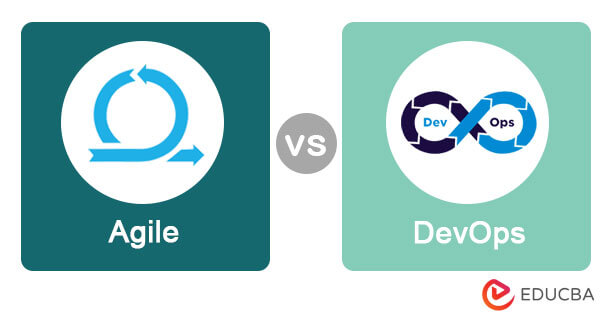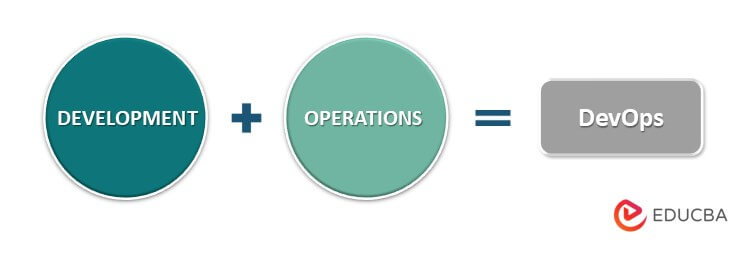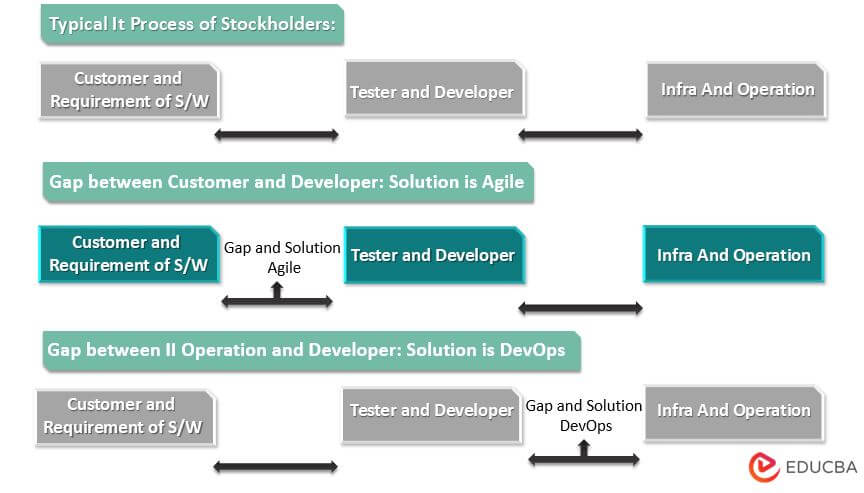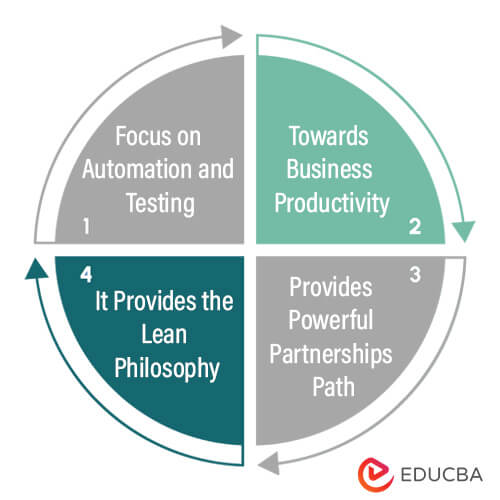Updated September 28, 2023
Difference Between Agile and DevOps
Agile vs DevOps is the comparison between two software development approaches that are used in the industry presently. We know that Agile is a process of identifying how we can develop software and deliver a good amount of coverage. On the other end, we have DevOps, which means combining two different words: development and operation, which is used to carry out the entire software development process with different phases. These two are different software development methods, but the aim is the same.
Table of Contents
- Difference Between Agile vs DevOps
- Agile vs DevOps (Infographics)
- Key Differences Between Agile vs DevOps
- Comparison Table – Agile vs DevOps
- Key Similarities Between Agile and DevOps
- Merging Agile and DevOps
What is Agile?
In the Agile process, we have a continuous iteration of software development and SDLC testing. In the agile methodology, we have a concurrent development and testing process similar to the waterfall model. In the Agile method, we use the divide and conquer approach. That means we divide the product into a small part of the module and make integration final testing with the help of Kanban, Scrum, etc.
Emergence of Agile
Agile has effectively replaced the incommodious method of the traditional ‘waterfall’ method in project management. In 2001, 17 application developers (termed the ‘Agile Alliance’) proposed the ‘Agile Manifesto.’ Agile Manifesto is a set of documents containing 4 values and 12 Agile principles, which offer software development guidelines.
What is DevOps?
DevOps is a software development technique prioritizes collaboration, integration, and communication among IT professionals. By emphasizing these factors, DevOps aims to accelerate product deployment while improving the overall quality and reliability of the developed software.
The culture of DevOps encourages development and operations teams to work together. Automated deployment of code to production is made possible by this. It helps an organization deliver applications and services more quickly. An alignment of IT operation and development is one possible definition.
Emergence of DevOps
In 2009, a Belgian engineer named ‘Patrick Debois’ promoted a conference about agile methodology execution on Twitter and captioned it ‘DevOps.’ Later, ‘DevOps’ day was held in Ghent (Belgium), after which it gained widespread momentum.
It has been garnering huge popularity, and several companies, mostly from the IT sector, are incorporating it as a part of their organizational culture to improve coordination and work efficiency. It is a cross-functional methodology that ensures quick and accurate delivery.
Head To Head Comparison Between Agile vs DevOps (Infographics)
Below are the top 16 differences between Agile and DevOps:
Key Differences Between Agile and DevOps
In the below diagram, we can see the basic difference between Agile and DevOps:
- While Agile is an iterative approach that emphasizes collaboration, customer feedback, and small, rapid releases, DevOps is a practice that brings together development and operations teams.
- Agile, on the other hand, only requires a small team for DevOps.
- DevOps uses the two moves, left and right standards, then again, coordinated influence shift-left guideline.
- Software development is the focus of Agile, while rapid delivery and end-to-end business solutions are the focus of DevOps.
- Conversely, Agile places a greater emphasis on functional and non-functional readiness than DevOps does.
Agile vs DevOps Comparison Table
Let’s look at the top Comparison between Agile vs DevOps –
| Parameter | Agile | DevOps |
| Goal | Determine the gap between the customer requirement and development as well as testing. | Determine the gap between development, testing, and operation. |
| Focus | Readiness of functional and non-functional. | Business and operation-related tasks. |
| Importance | Creates the process of building the software. | Testing as well as implementation are equally important. |
| Quality | Product owners have a better suite of all desired software requirements. It is simple to modify in response to timely modifications made throughout the project. | Better quality is made possible by DevOps, automation, and early bug fixing. To maintain quality standards, developers must adhere to best practices in architecture and coding. |
| Tool Used | Bugzilla, JIRA, and Kanboard | Puppet, Chef, TeamCity, and AWS |
| Speed vs Risk | Agile supports quick changes and makes a robust application. | The DevOps team must ensure that our changes to architecture never affect the process. |
| Communication | The most common Agile software development methodology is Scrum. Scrum meetings are held every day. | Specs and design documents are used in DevOps communications. It’s fundamental for the functional group to completely comprehend the product discharge and its equipment/network suggestions for sufficiently running the organization interaction. |
| Documentation | The agile method puts the working system ahead of complete documentation. When you are adaptable, responsiveness is ideal. Nonetheless, it can hurt while attempting to give things to one more group for the organization. | Process documentation is chief in DevOps since it will send the product to the functional group for arrangement. The impact of inadequate documentation is minimized by automation. However, transferring all necessary knowledge while developing complex software is challenging. |
| Feedback | The customer gives feedback. | The internal team gives feedback. |
| Target areas | Software development | End-to-end business as well as fast delivery |
| Shift left principal | It uses a left shift of leverage. | It uses left and right shifts of leverage. |
| Cross-functional | Any team member ought to be able to perform the tasks necessary for the project’s progress. Additionally, when each team member can perform each task, their mutual understanding and connection grow. | The operational and development teams are distinct in DevOps. Communication is, therefore, quite difficult. |
| Practices |
|
|
| Team Size | Agile believes in “smaller and concise”. The smaller the team, the better it would be to deliver with fewer complexities. | On the other hand, DevOps believes that “bigger is better”. |
| Advantages |
|
|
| Disadvantages |
|
|
Key Similarities Between Agile and DevOps
We can see the block diagram for similarities as below.
- Focus on automation and testing: Stability is the goal of both DevOps and Agile. They accomplish this by actively operating in a fast, secure, and quality-tested environment. This is accomplished by incorporating a great deal of routine testing into both approaches. They hold the same beliefs about how automation can make the execution process more flexible and secure.
- Towards business productivity: Agile and DevOps collaborate to achieve a common business objective: increasing productivity. Agile and DevOps both take a business-oriented approach. Carrying out the Nimble technique in the product improvement process allows groups to focus on a solitary objective, passing on space for them to save time and be more helpful.
- Provides powerful partnerships path: Paves the way for effective partnerships. Despite their many differences, DevOps and Agile emphasize creating a collaborative workplace where team members can easily and quickly share information, identify problems, and troubleshoot problems.
- It provides the lean philosophy: Agile and DevOps methodologies are influenced by the Lean philosophy, emphasizing continuous improvement and collaboration. Promoting effective communication and teamwork can create a positive and productive work environment where team members can work together more efficiently and effectively.
Merging Agile and DevOps
- It helps us to improve the teamwork flow as well as the activity.
- It helps us to define the lifecycle of implementation.
- Both include QA in each phase of the workflow.
- Provides the different tools.
- It helps us to handle the backlog.
- It also provides tools for collaboration, documentation, and reporting
Conclusion
Agile and DevOps are two modern software development methodologies emphasizing collaboration, communication, and rapid iteration. Organizations can create a more efficient and streamlined software development process by merging the Agile and DevOps methodologies. Adopting Agile and DevOps methodologies can help organizations improve the quality and reliability of their software products while achieving faster time-to-market and increased customer satisfaction.
Frequently Asked Questions (FAQs)
Q1. How are Agile and DevOps related?
Answer: Agile and DevOps are related in that they both aim to improve the software development process. Agile focuses on the development phase, while DevOps extends this focus to the entire delivery pipeline, from development to deployment and operations.
Q2. Do you have to be Agile to implement DevOps?
Answer: No, you don’t have to be Agile to implement DevOps. While there are synergies between the two, organizations can adopt DevOps practices independently of Agile. However, combining both approaches can lead to even more efficient and responsive software development.
Q3. What are some common tools used in Agile and DevOps?
Answer: In Agile, common tools include Jira, Trello, and Kanban boards for project management and collaboration. DevOps tools like Jenkins, Docker, Kubernetes, and Ansible are often used for automation and deployment.
Q4. How does DevOps improve software delivery?
Answer: DevOps improves software delivery by automating manual processes, enabling faster testing and deployment, and ensuring greater release consistency and reliability. It also encourages collaboration between development and operations teams to address issues more effectively.
Recommended Article
This detailed article lists the 16 key differences between Agile and DevOps. Along with the definition and how to use it, we have added when you can use the specific Agile and DevOps. For more easy-to-understand software development-based articles. You can view EDUCBA’s refer articles for more information.







